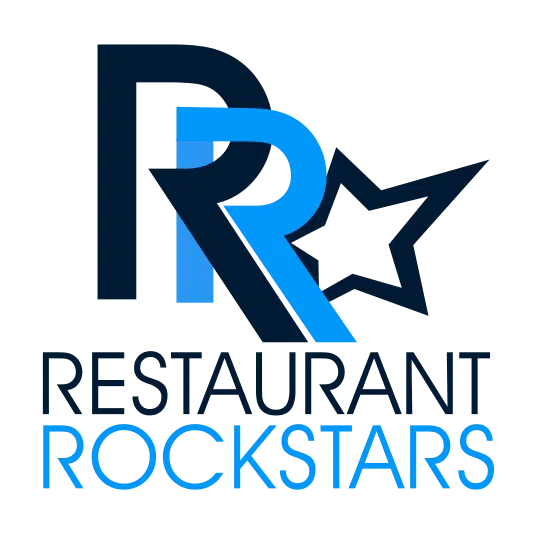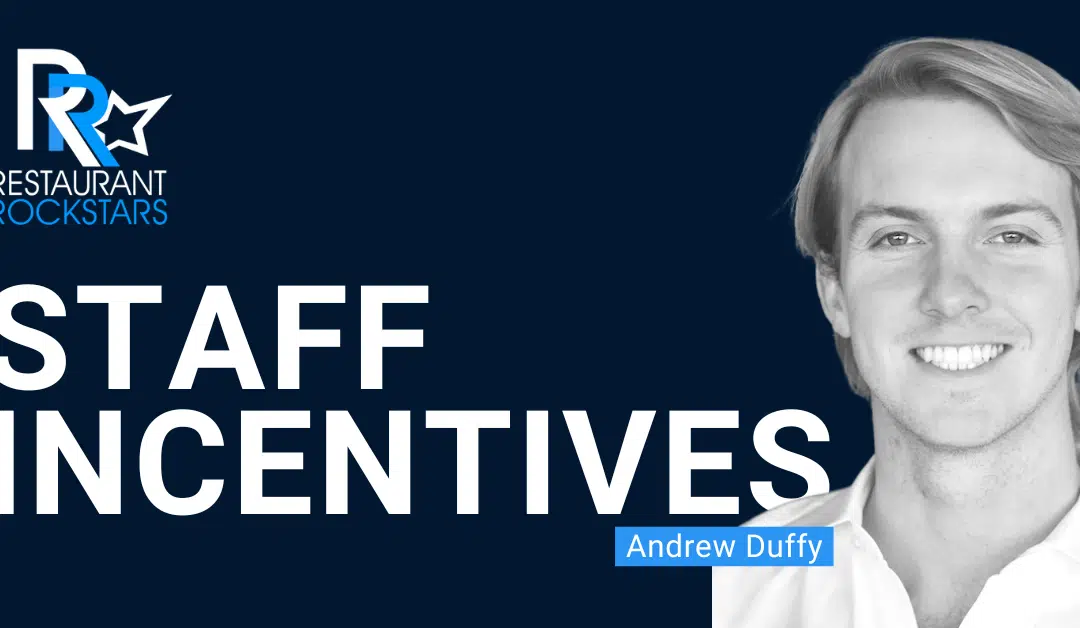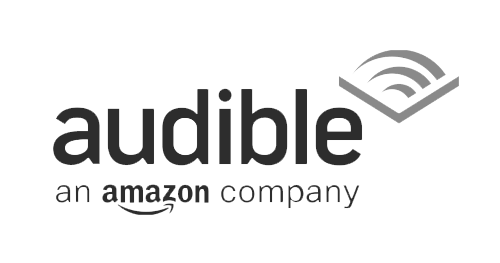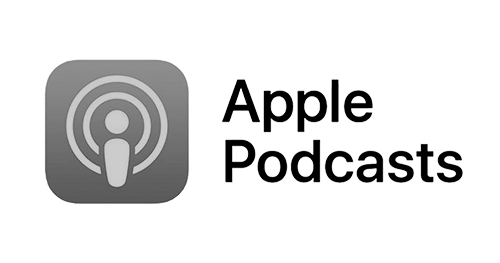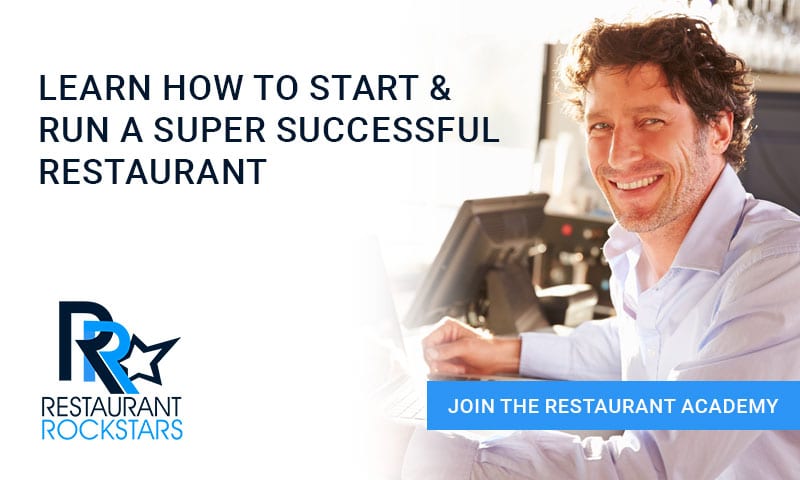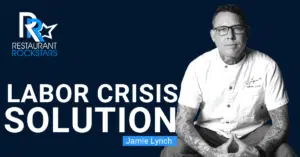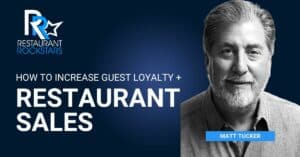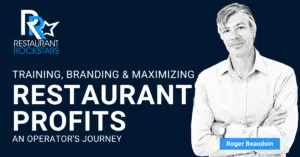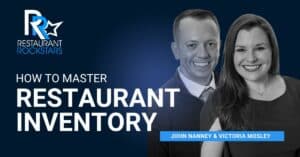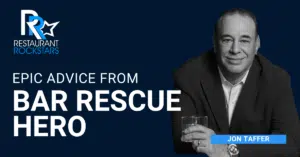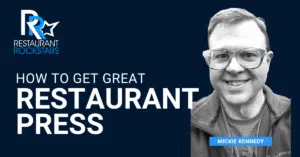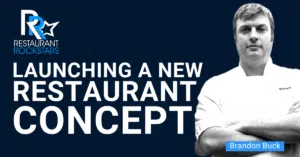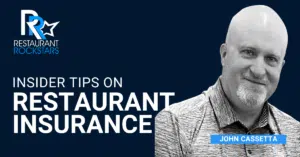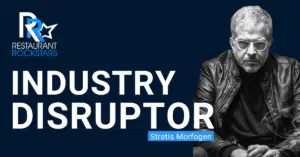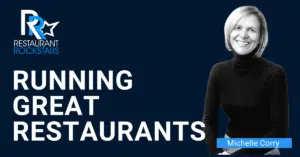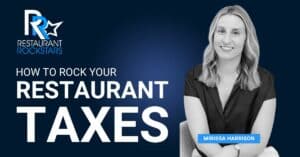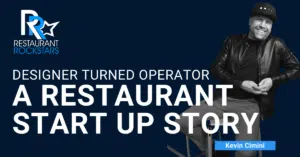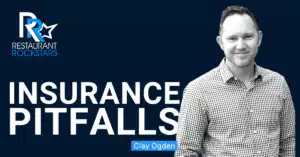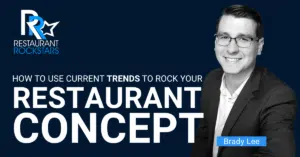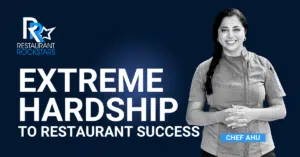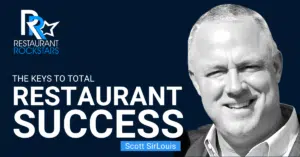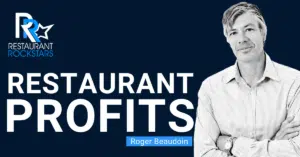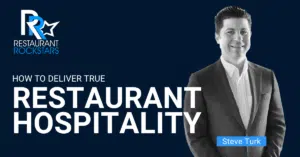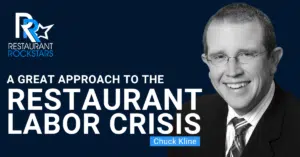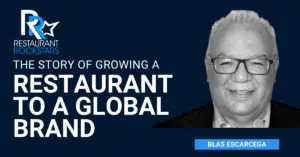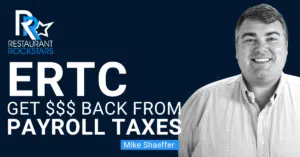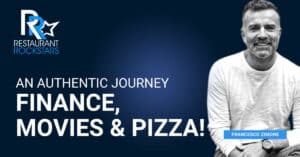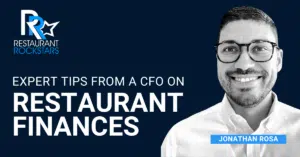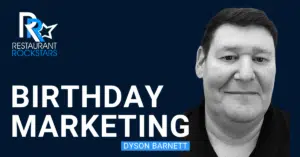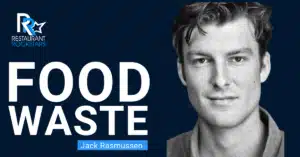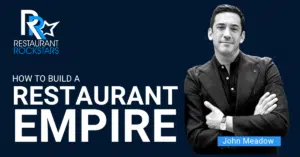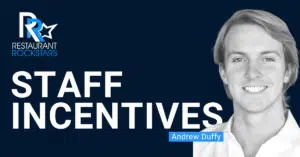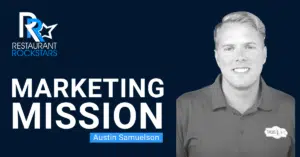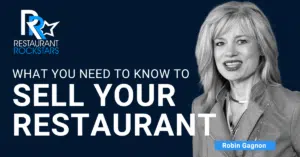Restaurant Rockstars Episode #300
Incentives May Help Solve Your Restaurant Labor Challenge
LISTEN HERE OR ON YOUR FAVORITE PODCAST PLAYER
Prefer to watch the interview?
Click the video below.
I had great success by incentivizing my entire team to strive for maximum performance and guest service.
You might say it was my “secret weapon” for over 20 years running restaurants. With the restaurant labor challenge, it’s more important than ever to keep your good people happy and create a culture that attracts new team-players.
In this episode of the Restaurant Rockstars Podcast, I’m speaking with Andrew Duffy, the CEO and Co-Founder of www.SparkPlug.App, the world’s first Incentive Management Platform for restaurants.
Andrew shares with us:
- The difference between Leading and Managing your team
- What Hospitality really means
- Why the disparity in restaurant earnings, and how incentives keep the entire team performing their best
- The results of polling 500 restaurant workers about their current compensation
- How to customize incentives for any team goal
- Capturing valuable incentives from your suppliers
And the importance of training, menu and restaurant knowledge to truly serve your guest.
The restaurant labor challenge is a biggie but you’ve got this!
Watch or Listen and then go out there and ROCK Your Restaurant!
Roger
Connect with Andrew:
Guest 0:00
A lot of retailers and restaurants are spending a lot of money very inefficiently to try to get people in the door. And that’s great. You need customers to come through. That’s obvious. But you could spend that money way more efficiently and make a significantly greater gain in the value that you create in your retailer or restaurant, just by adding 10% to your order averages increasing the amount that is sold on each ticket rather than trying to desperately increase the number of people coming in the door is a much more efficient way to take advantage of the customers that you already have coming in. No loyalty to your business are naturally via walk in or via word of mouth.
Roger Beaudoin 0:35
Welcome back, everyone. Thanks for being with us on the podcast, you know that I am a huge believer in incentivizing a team and creating a dream team staff. So today’s episode and guest is really all about how we can uplevel the performance and the satisfaction of our team. Now it’s common that there has been a disparity forever between front of house and back of house and different pay for different positions. And we’re going to be talking all about that. And this could also be your potential solution to the labor crisis. And if you haven’t already, head on over to restaurant rockstars.com forward slash profits. I’m giving away three ways you’re killing your restaurant profits, immediately actionable thought provoking information that will help your bottom line now on with the episode.
Intro/Exit 1:24
You’re tuned in to the restaurant rockstars podcast powerful ideas to rock your restaurant, here’s your host Roger Beaudoin.
Sponsor 1:38
Imagine both your front and back of house teams are so well trained that they’re executing flawlessly. Your front of house is doubling your sales, boosting repeat business and creating five star dining experiences. While your backup house is consistently preparing each dish to perfection on time and to spec having a restaurant this dial takes a unique trading system. That’s where surf comes in. SRV means study restaurant variety, and it is a powerful mobile training system custom built to meet the needs of your restaurant serve will uplevel your team’s knowledge and skills, maximize your profits and create experiences that guests will rave about serve is the key to unlocking your restaurants hidden potential, and will prove that the more your team is able to learn the more your restaurant will earn it and it’s a game changer. Ready to get started @ srvnow.com
Sponsor 2:36
Restaurateurs and managers every day guests are asking your servers one simple question that can make or break your bottom line. That question, what do you recommend? Studies show that 92% of diners will order whatever their service suggests. So if you’re not already doing everything you can to harness the influence of your frontline team. It’s time to start. I’m excited to introduce you to sparkplug and all in one customizable incentive management platform designed for restaurants. sparkplug fully automates sales contests, goals and commissions letting you build incentives, track metrics in real time and fulfill prizes in one dashboard. Over 1000 businesses are using sparkplug to motivate and engage their front of house to ensure they always have the perfect answer. When asked what do you recommend, and now you can too. spark plug is free to try and is offering my podcast audience $200 off their first sales incentive. Visit sparkplug.app/rockstars to claim your $200. That’s sparkplug.app/rockstars.
Roger Beaudoin 3:46
Welcome back, everyone. This is the restaurant rockstars podcast with me today. Mr. Andrew Duffy. He is the CEO and the co founder of sparkplug, which is the world’s first incentive management platform for restaurants. Welcome to the show today, Andrew, how are you?
Guest 4:02
I’m great, Roger, thanks for having me.
Roger Beaudoin 4:04
I’m excited to have you here because you know, technology is moving forward every single day in this industry. And it was doing that before the pandemic but now the pandemic has really shifted things into high gear. So of course, we’ll talk all about what sparkplug is. But before we do that, my guests know I always ask the backstory, it’s really kind of interesting and relevant what my guests have done in the hospitality space, where it all began for them because this is a business of passion and pride and all those things. And if you’re in this business, you’re in it for a reason. So tell us anything that’s, that’s relevant to your story.
Guest 4:37
Absolutely. My family has pretty deep roots in the hospitality world. I remember growing up hearing stories about my Dad’s experience, working at shaky pizza in Arizona and then moving on as a lawyer to ultimately be a union organizer and rent strike organizer on behalf of primarily hourly workers. So I was always inspired by his example to not only Eat, think about and work on behalf of the economic underdogs in our society, but also to really engage with what it means to experience service and hospitality from the other side of the coin, not just receiving it, but also giving it so let’s see in high school, I worked every summer at the cactus Cantina in Northwest DC. That was where I was the top seller of gold Cadillac, margaritas, three summers in a row, which I was always quite proud of. I also worked in retail worked at Abercrombie as a clothes folder, worked as a bartender at a wine bar for a short time before college as well. Yeah, had a lot of experience in that realm. And more than anything, I think what that has filled me with is a deep respect and understanding of how challenging those roles really are, and has made me feel that compensation for those roles. And how we think about the difficulty and importance of those roles in our society is totally out of whack today. So yeah, that was where I really started, I’d say in my hospitality journey, before taking a little break for school, as well as working in the finance world. And then, you know, kind of came back around with sparkplug
Roger Beaudoin 6:09
that’s quite a bit of experience. I mean, it definitely hits deep into the trenches of well, that word hospitality did come up. But what diverse experience, we talked about finance, you talked about multiple jobs, we talked about being a sales champion, which is so important in the front of house. And I want to talk about all those things when we get into it. But that’s that’s definitely relevant. And thanks for answering that question. Let me ask you about your definition of hospitality. Because it’s really, I think it’s a rare thing. I mean, there are lots of really dialed restaurants out there that really practice it. And when I mean, practice it, it’s not just a mission statement on the wall. It’s like it’s indoctrinated into the team into the staff. And they’re literally there to make friends with their guests every single day, give them lots of great experiences, give them reasons to come back, it all leads to positive online reviews, that is critically important. But it sounds like at a young age, you automatically just got it and you had that pride, you certainly had that competitive spirit, because we talked about, you know, being a salesperson, and that is so important. And what really disappoints me when I travel is I still run into order takers all the time that just sort of leave the chips on the table, provide ordinary experiences don’t really bring the food and the experience to life for the guests. And they’re missing huge opportunities. But somehow you innately knew that or at least I’m getting the sense that so what did hospitality mean to you, then? Did you equate hospitality to increased earning power? All that sort of thing? Tell us about that. I don’t want to speak for you. But this is what I’m getting when you tell me that story?
Guest 7:43
That’s a really interesting question. I think the concept of hospitality, to me has always been tightly intertwined with the concept of empathy. As a provider of hospitality, you have to be extremely empathetic and understanding how the guest customer, whatever format is receiving that experience, what do they feel when they walk in the door, when they sit down? When they order? What is the degree to which they want to feel waited on and closely attended to, or what is the degree to which they want to have their own space and have a private conversation with the person they’re dining with those types of empathetic understanding moments of exactly what’s happening in that customers experience, I think, are the key to hospitality. And that will then open up opportunities to more effectively meet that experience and provide the exact degree of value that they’re looking for, which is where you get the additional sales opportunities, you know, maybe they want to have a little bit more of a let loose night with their friends. Okay, that’s the opportunity that I always sought to give a gold Cadillac Margarita into the mix. And in the same way, in any of these scenarios, it’s really paramount that the person who’s working the floor working the table working the bar is identifying and executing on those opportunities. Now, I think what I also really experienced in what felt key to hospitality, to me in that early at that early age, was that empathy is exhausting. It takes a lot of energy to really look at and dig into and understand the people that you’re talking with and working with, particularly on an eight hour 10 hour or 12 hour shift or you’re on your feet the whole time. You know, you have to really be bought in and fully energized to give that quality of service. And I think that’s more where the disconnect comes from. Everyone really in hospitality, I think is capable of empathy, and is capable of being a really effective executor on those goals. But it takes a lot of energy. And it takes a lot of motivation to do that. And it also takes a lot of skill. So I think when you set people up to succeed in those environments to be those empathetic providers of service, then they can almost always do that. But it’s more about the environment you create for them and the systems you create for them than it is about just hoping that you’re going to find the right person who walks in off the street to be you know, a great server or a great bartender something like that. Yeah,
Roger Beaudoin 9:56
I mean, it takes a specific personality and train Nene can develop those skills in people. But it definitely takes training that begins with an understanding of what Empathy means. And we’re also really talking about finding that delicate balance sometimes between being very knowledgeable and being very presenting and being very attentive to needs, but also respecting people’s time and what’s really important to them and somehow delivering hospitality when not being intrusive. So that’s really what it’s all about. That’s, that’s what I got from what you just said. So awesome.
Guest 10:31
Definitely. And I think that the really key piece to that, that I carried through from my experience, as a college student, or I studied behavioral economics and labor economics, and then in finance, where I studied, you know, even more deeply the structure of economic systems for laborers, and how ultimately, they’re motivated to execute on their work. And what we found was that, it’s not necessarily about giving people all of the right inputs and the right education and the right skills, it’s more about motivating them to acquire those skills and motivating them to aspire to that ability to execute on what you really want them to do in your store or in your restaurant, or in any environment where you’re employing people. So I think it can feel like it’s overwhelming. It’s so much stuff to try to teach and engage with, and get these employees to execute on. But in reality, it’s more simply about creating the right motivation for them to aspire to be that really excellent, hospitable server.
Roger Beaudoin 11:32
What if you could think back to your restaurant experiences when you were a team member in the front of the house? Do you remember having different managers or different people that you reported to and what those styles their management styles might have been like? And were any of them really something that you would remember to this day as being super effective in motivating, inspiring and getting the most out of people versus, you know, just being a boss who tells people what to do? What can you remember any of those experiences and any specific person that it’s you don’t have to name them by names, just what they were like, and how they inspired you and your team members to perform and to, you know, really, because the end result was the guest experience. And I believe that, you know, the manager or the leadership in place has such an ultimate resulting impact on the guest experience through the way he interacts with his team and trains and develops them, you know, what I’m saying? What would you say about, you know, people you might remember and what was really memorable and what was really effective about their style?
Guest 12:35
Absolutely. So, at the cactus cantina, which was a family owned restaurant, there was a rotating cast of essentially three, three main managers and they each have very distinct styles. So they stick out pretty distinctly in my head. One was the very brash and boorish manager who was always managed by a consequence, you know, taking away shifts if you weren’t performing in the right way, or, you know, getting upset if you weren’t executing on exactly the right task at the right time in the right at the right pace, and very rarely, actually ever finding themselves doing something on the floor, they were very much, you know, directing, they were the generals standing up on the hill overlooking the battlefield, not really actually engaging with what had to happen with the customers. That never really worked with, for me, and I don’t think many of our team members responded to that particularly well. Then, on the flip side, a manager who was much more a player coach, I guess, is what I would call her, she would never ask you to do a task that she wasn’t already willing to do herself, and which we didn’t consistently see her jumping in to do when everybody’s hands were full. And we needed just an extra hand to dive in. And actually, you know, get us the help that we needed to move that thing across the labs. So her role was very much in sort of unlocking the team to not only remove some of that stress and that pressure and make us feel like she was really on our side and sort of in our ranks. But she also very much lead by example. And people would naturally start to do those things because they saw her doing them. And they didn’t feel like they were, you know, tasks to be executed on and instead felt like they were things that they sort of owed to the team to be a really effective part of it. So in general, she was more I would say, a leader than a manager in the sense that she was really driving the behavior of the team via her own behavior. And then the third one, who, in some ways, was an inspiration for sparkplug was, I would call him he was kinda like the motivator, he would essentially, you know, he’d wave around like a $50 bill and say, Hey, Whoever sells the most of this today is going to get whoever was the most rational today is going to get this $50 bill at the end of the shift. And interestingly enough, the the results that we got with that manager were the highest by far always. So in Many ways, despite, you know, the more brash consequence oriented management, or the more sort of in person rank and file leadership, and what actually kind of moved the needle for the restaurant the most from the ownerships perspective was just rewarding people for their efforts and getting them really stoked on doing it effectively.
Roger Beaudoin 15:17
Wow, that’s awesome. That’s quite a contrast between styles. And clearly leader, you know, leading by example is certainly important. Because, you know, in restaurants, not every day is a stellar day, you know, people have their personal issues that affect their performance, which is always a challenge, because you never want the, you know, the guests to see any behind the scenes drama of any kind. But everyone has their lives outside of a restaurant and leaving that at the door and coming in. And really being able to perform is one thing, and not every day is a stellar sales day, either we have slow days, we have super busy days, and you have to take the good with the bad. And yet, healthy competition is super important. So sort of blending those styles I’m hearing would be effective. So if the guy who’s always got the $50 bill having a sales contest, also lead by example, I’d say that’s, that’s pretty solid stuff. But thanks for sharing. So the pandemic has turned everything upside down in this business, and it’s sort of created this whole new dynamic of running a restaurant and the labor up evils are still the biggest problem right now. Because you Okay, so everyone’s gone through the pandemic, and if the restaurants still standing, and if you’re still out there, you’ve been beaten up, obviously, really bad. But now the labor crisis is ongoing. What do you think? In your opinion, what have you seen, it’s like, what, what is the cause, because restaurants have been hit harder than any other industry. And just about every industry is struggling with this right now. And people seem to have evaporated, and everyone’s got a theory, what happened to all the people, and one, you know, restaurants, traditionally, I don’t need to tell our audience or yourself this, but it’s like, traditionally, we have not been a high paying industry, you know, and it’s been really hard to compete with other higher paying industries. And there’s a certain amount of defection that happened before the pandemic, because people need to live and people need to, obviously, you know, pay their bills and have obligations, save for the future, all that kind of stuff. Yet, restaurants have always been a fun industry, you know, so maybe a lot more fun working in a restaurant, but you might not have made as much money working in a restaurant as before. So let’s go back to this labor crisis thing, because it’s ongoing. And a lot of restaurants try to hire versus recruit. And there’s a whole difference in the kinds of people you’re going to get, but in your own opinion, tell us about, you know, your theories about labor and challenges and why people haven’t stayed and what it’s going to take for restaurants to bring this back around. So that one, it stays fun, and two people are happy to be there. And three, that team chemistry goes up and for they’re incentivized to be there because we have to pay higher wages than ever now. So that’s that’s a mouthful. I know. But you know what I’m saying? I’d love to get your opinion on the whole labor situation.
Guest 17:57
Absolutely. It’s it’s extremely complex, like you mentioned, I think there are a couple of key points we can pull out and key turning points in the trajectory of the labor market through time. So I think even long, long, long pre pandemic, we’ve been seeing a meaningful disempowerment of labor over time. And that’s reflected in a lot of the infrastructure of labor generally, decreasing its power, like unions have decreased in memberships significantly, since their heyday in the earlier part of the 1900s. And that, I think, is reflective of the degree to which a lot of employees in these environments, these hourly labor environments don’t necessarily identify tightly with their work, they feel that they are disposable, and that their work is disposable to them as sort of a mutually assured question. And that ultimately met the pandemic at pretty much, you know, the worst possible point there was so much Tinder sitting there that was lit by the match of COVID, which ultimately was driven by that decrease in union power, that decrease in employee engagement with their work generally, and ultimately, the stagnation or even in some terms, the decrease in wages that those employees were earning, right, and the degree to which they were being sort of priced out of their lives, like you mentioned. So with all of those things coming into the pandemic, we then have this generational shift in how we consider these hourly roles, particularly frontline roles where you’re interacting with a significant number of people. So instead of seeing that as an exciting and engaging part of their work and seeing their restaurant workers may be more flexible, because they can pick shifts when they want or they can ultimately, you know, work at this restaurant jump to that restaurant. Now they find themselves in a scenario where they’re the ones who are trapped, they feel in a dangerous situation, engaging with people who might infect them with COVID. And all of the deskbound knowledge workers who were previously you know, the office drones are now finding themselves sitting back hanging out at their house working over zoom, or in many cases traveling around becoming digital nomads sort of live Seeing what you know, at least on Instagram looks like their best lives, and ultimately creating this really clear class dichotomy between the hourly laborer who is stuck in their job and tethered to their job and is having this miserable experience versus the knowledge worker who is, you know, maybe experiencing something a little bit different. It’s not to say that that wasn’t a difficult experience through COVID for all types of people. But that was a very, very meaningful differentiation in the way that different labor classes experienced that pandemic. So qualitatively, I think that was a big reason for the breakage. A lot of these employees felt like, well, this is what’s motivating me to stay here. Why am I ultimately working in this job if I don’t have any of the benefits that all these other types of workers do. And that I think, is ultimately tethered to what I see as the key breakage in hourly labor generally, which is that when restaurants or retailers thrive, the owners earn more, and the employees earn the exact same amount. And that will always drive a meaningful breakage, because those employees will never be motivated in the same way that the business is their goals will never truly be aligned with the business because they are earning a fixed hourly wage. And they are not necessarily earning based on their performance. And that’s the real challenge that we have to solve to make sure that we can get people coming back into brick and mortar labor and feeling like that’s something that they’re excited to do. Because they need to be both financially motivated, and interpersonally motivated to want to engage in those roles into the future, because we will, for the foreseeable future, always need those types of people working in those types of jobs. And we have to make sure that those are jobs that can be both economically sustainable for them, and actually enjoyable for them to work, or at least give them a sense of fulfillment through time. And that’s where that motivation piece comes in.
Roger Beaudoin 21:48
That’s excellent. That’s absolutely true. I totally see that. Now. sparkplug recently pulled 500 hospitality employees, and it was all about current compensation. Can you tell us what you learned from that survey?
Guest 22:02
Yeah, absolutely. So ultimately, what we learned is that tipping is not necessarily the motivating force that we once thought that it was, a lot of different employees in the restaurant environment feel that they are not being properly compensated for the work that they do, and that they are not effectively being motivated by, you know, the tips that they get or the consistency of the value that they get out of their work. So ultimately, what we found in this engagement is that a lot of these employees need a new source of external motivation for their work, they need to feel like they are getting rewarded effectively for what they’re doing. And that when they perform over and above expectations, that they ultimately are getting a reward for that. And that’s, I think, a slight change from what we might have expected. You know, I think when I was working in the restaurant space, I felt that tips were at least somewhat aligned with the value that I was, you know, creating in the store. If I was adding more drinks to a ticket, then ultimately, I was going to get, you know, say 20% of those as an additional sort of payout on top of that. But in the pandemic and post pandemic period, we’re seeing tipping contract, and people feeling like they need to tip less and less particularly as inflation makes them feel like their money is not going as far as it used to. So a lot of employees are feeling that squeezed. And they’re ultimately not having that sort of back filled by their employers to continue giving them that motivating factor. And making them feel like they can ultimately you know, earn when they create value.
Roger Beaudoin 23:35
Get big flavor without the labor with smoking fast from Smithfield. It’s fully cooked or smoke proteins, including American barbecue staples, and global flavors. Everything from ribs to pull chicken to brisket and barbacoa. All are authentically slow cooked to perfection. It’s so delicious. Your guests will never know it wasn’t smoked right in your own kitchen. Now you can add barbecue to your menu without adding a pitmaster to your payroll, visit Smithfield culinary.com Absolutely true. Now, systems are so important to effectively run restaurant operations and they were important before the pandemic, now new systems have become critically important related to technology. You know, we talked at the beginning about how technology is constantly moving forward every single day. What in your opinion, Andrew is just critical operational technology that every restaurant is going to need into the future. What do you see there?
Guest 24:32
Yeah, so in general, I think that, from my perspective, some of the most key technology beyond your sort of baseline set of operational tools like your point of sale system, that’s just tracking what’s happening, maybe your back of house logistics system that’s allowing you, you know, hopefully as an integrated piece of your POS to track, you know, how things are moving through the kitchen and ultimately getting out to the floor. You know, once you have those really sort of core baseline pieces of your infrastructure set up And ideally with a great POS system that will cover things like delivery or online ordering, or you know, any of those other additional factors that pop up through time, you know, a good POS system will be consistently adapting to that, and adding new features to be able to engage with any new tools that you might need. So that’s a really critical bedrock. But then, you know, from our perspective, what we see, particularly with the implementation of a platform, like spark plug, is that you need a toolkit that allows employees to be engaged with the performance of the business and feel like they are a part of that performance, and that they are aligned with the goals of the business. So giving employees visibility into their performance and their ability to contribute to the overall performance of the business via that individual performance. And then also, ideally, rewarding them for that performance. And using really clear tooling to be able to distribute value out to them so that it’s super easy, it doesn’t add any additional work, they don’t have to be taking pictures of the receipts or doing this or doing that, they can just take that data, look at it, engage with it, and then ultimately perform better based on their motivation to get those rewards. So you know, a tool like Spark Plugs sort of sits on top of the point of sale system, and uses the data from, you know, all those transactions to track and integrate and essentially allow those employees to view and iterate on their performance.
Roger Beaudoin 26:15
Alright, so I’m hearing that contributions and feeling like your contribution matters is super important, because everyone works for a paycheck. And yes, incentives and money is super important. But feeling like you’re part of something bigger than yourself, and that you are aligned with the goals of that business I heard you just say is super important. But I think we also know that traditionally, this industry has had a disparity in earnings in a restaurant. So are you saying that those two things combined were really the brainchild for sparkplug and tell us, you know, tell us about the brainchild for sparkplug and then let’s get into what it does, how it works and why it’s there.
Guest 26:51
Totally. Yeah. So I think what we found really, even in the earlier stages, before, we had identified things like those clear pay disparities in different spaces, or the sort of, you know, pre COVID, before the labor crisis was even really a thing on people’s minds, we identified this really big gap between the fact that we see retail and restaurant environments is so important, they are so important to the economy, they are, you know, creating trillions and trillions of dollars of value. That is a consistent year over year growing slice of how people spend their money in the US at leisure. And we consider all of the employees who work there to be essentially entirely disposable. And the idea of being a career retail worker, a career restaurant worker is unthinkable for many, and is embarrassing to some who find themselves in that position. And that to us is shocking and doesn’t really make sense. You know, what other part of the economy is so meaningfully driven by a particular group of people and is so meaningfully impactful on the overarching economic value of our system, but feels so disposable and has so little respect for roles. So that was sort of a big turning point for us and thinking, wow, there are a lot of people who are creating a lot of value but aren’t getting value in return and don’t feel like they can make a career out of the value that they create. So that sort of qualitative piece. And then quantitatively as we really started to look at these different markets in both retail and restaurants and identify exactly where we thought, you know, the platform was the most applicable and where it could have the most impact. We found that in pretty much any environment where there is a point of sale employee who is impacting what people might choose what they might pick up off the shelf, or purchase what they might order off the menu, there was a huge amount of value to be created by just slightly incentivizing those people to push for maybe one more item or to cross sell something that the customer might like to try or to upsell them to a new service to get them from, you know, the middle shelf liquor up to the top shelf liquor. So when we really dug into the data, we found that a lot of retailers and restaurants are spending a lot of money very inefficiently to try to get people in the door. And that’s great, you need customers to come through. That’s obvious. But you could spend that money way more efficiently and make a significantly greater gain in the value that you create in your retailer or restaurant, just by adding 10% to your order averages increasing, the amount that is sold on each ticket rather than trying to desperately increase the number of people coming in the door is a much more efficient way to take advantage of the customers that you already have coming in, you know loyalty to your business or naturally via walk in or by a word of mouth. So when we realized that that quantitative dynamic that fit immediately into our understanding that hey, qualitatively these employees are undervalued and quantitatively they are also extremely undervalued and that there’s a lot of dollars that we could drive towards them that would result in higher ROI for these restaurants and retailers. That and driving it out into, you know, digital marketing or wherever it is that they’re using to try to acquire these customers. So that was really where sparkplug came together. And that’s when we launched it into retailers and restaurants and found a lot of success there.
Roger Beaudoin 30:12
All right, they defined it earlier as the world’s first incentive management platform. So let’s literally talk about onboarding a new client, and what the timeline looks like. And what happens. And you mentioned earlier that it’s something that’s I believe you said it was mounted to the point of sale, and it’s got a data capture, obviously, to it. And it’s incentive based. I mean, all the things that we’ve been talking about are all rolled into this tool. But let’s talk about let’s get into the nuts and bolts of how it works and how you onboard a client and what happens immediately.
Guest 30:42
Yeah, absolutely. So practically, you know, one of our big rules for the product is that it has to be extremely easy, because restaurant employees and restaurant managers are extremely busy, and they don’t really have time to be working on huge tech implementation. So, like you said, we plug into the point of sale system, you know, whatever Splinter Cell system we use, you use in your retailer restaurant, we can plug right into, you know, one of our first big partners was square. So we’ve worked with a lot of, you know, square customers, to make sure that the tool is as simple and easy to onboard as possible, because with a platform like square, they are extremely used to everything being super quick turn on and operating, you know, easily and smoothly. So essentially, the setup process is about five minutes for a retailer restaurant, all they have to do is hop in to their POS basically flip a switch that activates spark plug, if it’s one that we already integrate with, and then they’re ready to go, we have access to the meaningful data that’s going to be used to determine exactly who has sold what products and therefore what incentives they should earn. And then it’s a super easy process for a manager to pop into Spark Plug and say, You know what, we are selling a little bit below where we’d want on desserts this month. So I’m going to offer a $2 incentive on every dessert that you sell on, you know, over the course of this month, each of the employees then gets a quick text notification, which says, Hey, this is a new incentive that we’re doing this month, over the course of the month, they can get periodic reminders indicating to them, hey, don’t forget about this dessert incentive, here’s how many you’ve sold, here’s how much money you will earn at the end of the month, you know, because of how many you’ve sold. And maybe here’s the goal that you could get to if you keep selling at this pace. So we engage the employees in a super easy, simple way, just pops right into their phones. And then at the end of the incentive, we can manage all the distribution of those funds. You know, if those employees want to get that reward directly through that texting methodology, that’s superduper, easy. The restaurants can also pop it right into their payroll to make that easy as well. But ultimately, it’s a super simple process for everybody involved, but keeps everyone’s super motivated and aligned with what incentives are going on. So that the performance for those restaurants is significant. So, you know, in the case of the restaurant incentives that we typically run, you know, we see anywhere from the average of about 45% increase in sales of incentivized products, all the way up to you know, we’ve seen like 800% increase in sales for products that are, you know, really catching the eye of the customer and that employees just need to kind of push a little bit to get those customers more interested in.
Roger Beaudoin 33:11
Is there a separate reporting system that runs through sparkplug, when you’re tracking sales performance, like we all know that every point of sale system, you can literally plug in all the people that are on the floor on a week or a day or a month or whatever? And see, you know, whose sales performance is where but how do you separate the specific sales performance that is Alignable with the team incentives that you custom create for the client or that they decide is important that they implement?
Guest 33:40
How is that great question? Yeah, so it’s super simple. It is accessible via any web browser, you can basically just pop in and log into your sparkplug account. And then that shows you a dashboard not only of your employee performance, which you can slice and dice however you want. But it also gives you side by side visibility into the incentives that you’ve run that have most impacted those employees and impacted sales over time at your at your restaurant. So you can super seamlessly identify what actually drives value for you what has done so historically, and what you think will do so into the future, you can a B test really easily to see, hey, looks like this type of incentive really worked for desserts and this type work for alcohol. But you know, in some scenarios, it might work different for different products. So it gives you a lot of visibility to the data to be able to analyze that and extreme flexibility and the types of incentives that you can run they can be, you know, percentage commission, if you want to just build a 20% tip essentially into every every ticket then it’s super easy to make that the way that it works or maybe a 20% commission on particular products that you’re trying to move that are on special or that are new in the store and the restaurant or you can create leaderboards so competitions between employees to hit say the highest order averages or to sell you know, the most tables this month. You know, it really is simple for them to create basically any form of incentive that they want be that a goal a contest or you know a commission style. Rock Stars.
Sponsor 35:01
You know paying bills is one time consuming restaurant detail in 1000 other details. With plate IQ your accounts payable is handled accurately and automatically. Plate IQ works with 30,000 restaurants of all types eliminating manual data entry in your accounts payable process. Technology takes care of line item General Ledger coding to invoice payment through plate IQs vendor pay network. Now no more paper checks. Your restaurant can seamlessly flow from invoice, upload to payment, and even earn cash back from paying over 180,000 vendors in the network on time. Played IQ is your paperless digital filing cabinet that frees your workspace from invoices, receipts and statements. You can search anytime by date, item or vendor. See when everything is due in manage schedules, approvals, payments, and filing right from your mobile pay digitally by cheque ACH or your plate IQ card. Best of all, no money leaves your account until it’s received by your vendor, which improves your cash flow and cuts confusion, it’s time to check out plate IQ at plate iq.com. Now, I’ve always believed that product menu product knowledge is what I’m talking about. Combined with restaurant knowledge, you have to be really obviously well informed and know the menu inside now know what makes this restaurant special and unique and different because you’re a brand ambassador for your business. Okay, so I’ve always believed that that training is essential before anyone can even learn how to make suggestive sales and to be motivated by contests they really need to know the ins and outs of obviously the menu in the restaurant because guests ask questions all the time. I’ve always believed it’s a negative impression, if you have to say, Oh, let me go ask someone or let me ask the manager, you know, because you gotta know you can’t sell if you don’t know. So are you seeing that a lot of your clients already have these these training systems in place before they actually can benefit the most from sparkplug? Or is it kind of a hand holding process where you sort of say, hey, this has to happen in order to get the most out of this? You also need them to know that? I mean,
Guest 37:13
that’s a great question. I mean, yeah, so with, you know, we go into each of these environments with the expectation that they’re doing, you know, some at least light form of onboarding training so that people can, you know, identify, at least what is on the menu. But we actually typically recommend and find the best results when spark plug is sort of the first employee facing platform for motivation or education that they’re using. Because we often see people use education and motivation, kind of the wrong direction. So like you mentioned, there are kind of two aspects to selling effectively, there’s skill, which is knowledge about the product, and about the restaurant, and you know, anything that you might need to get the customer a good understanding of that thing. And then there’s will, which is the motivation to actually apply that and the ability to, you know, like, we talked about empathize with the customer put in that effort and make that sale. Now, you might think that skill is required before will, but more often than not, they’ll acquire skill if they have the will. So when you give them that motivation, we find that once we’ve set incentives on particular products, or we’ve set you know, some degree of reward for whoever selling the most, you know, the highest order average, the employees will actually ask for education, they will ask for more knowledge about the product, they will start to on their own volition, train and learn more and collaborate with each other to figure out, you know, okay, how can I speak best to this product? So I think while it does, obviously require them knowing, you know, at least what the dishes are on the menu, maybe what the ingredients are sort of having that baseline understanding, so they can speak to the customer, if they have, you know, an initial question that motivating them to dive deeper and learn more and be able to give better recommendations as to the first step. And then you can tackle, you know, an education platform or something that’s going to be distributing that information. Maybe as a second idea.
Roger Beaudoin 38:57
Let me let me shift gears here for a moment, because a lot of what we’ve discussed is all about, obviously, what happens on the dining room floor. And the interaction between front of house staff and the guests and sales goals and hospitality and all that stuff happens front of house. And some would say that, you know, the back of house when we were talking about disparity in earnings, you know, there’s always been somewhat of a conflict between, you know, I’ve had servers in my restaurants that had these stellar nights where, hey, I just made $700 Tonight, because, you know, we really rock and roll. And then you had the back of house people that worked under seemingly more difficult, hotter conditions, who, you know, I made 16 bucks an hour, you know, and you always tried to keep the front of house staff just keeping their mouth shut. And don’t say this in that because it leads to this sort of morale issue and conflict. So is there sort of an incentive program that sort of carries over to the entire organization with sparkplug Where do you see that coming? Where do you stand on that?
Guest 40:00
I love that question the back of the house is by far the most underappreciated piece of an already under appreciated slate of employees that work in these restaurant environments. sparkplug is designed so that you can reward essentially any employee that works at the business for outcomes as long as you can track those outcomes in your say, your POS system. So like I mentioned in the sort of core infrastructure of a of a great restaurant, having the POS managing the transaction and the interaction with the customer. And then having either features within that, or a platform that helps you to separate from the POS, manage the flow of activity in the back of the house is really, really critical. Because that’s also what we like to build sparkplug incentives on top of, and you can create rewards wherein, you know, similar to, say, a pooling tips model, you can give back of house employees rewards based on the number of dishes that come out, or the average time that it takes for those dishes to come out, or the overall performance of the of the restaurant that night, give them a reward, you know, as a as a portion of that, or just more generally setting them, you know, the same types of motivating incentives that those point of, or those front of house employees get. And I think that that’s really, really critical. Because in large part, the the challenge of the back of house employee is not just that it is backbreaking, it’s hot, it’s difficult, it’s hard work, you know, when I was a server going into the kitchen, I’d be standing there for 30 seconds and be like, Oh my gosh, how do people stay in here all night, it’s so hot, it’s so noisy, it’s there’s so much stuff going on. Like it’s a tough environment to be in. But maybe even more than that, it’s a lot less motivating. Because what as a front of house employee, you know, you’ll have some some nightmare scenarios, for sure. But more often than not, you’re getting a nice, thank you, you’re getting a nod, you’re getting to see people enjoy their meal, you’re getting to interact with people and have sort of that nice, you know, experience of providing that service. Whereas the back of house employees really don’t get that sort of qualitative engagement with the customer. And that can be really demotivating. If they feel like they’re just kind of sitting there plugging away at you know, a really difficult job and not getting any type of reward for it or seeing the fruits of the you know, the outcome in the front of house.
Roger Beaudoin 42:16
I understand that some of the incentives actually come from vendors that a restaurant works with, can you explain how that works? And then there’s also you know, there’s instant payouts, but then there’s prizes and incentives that actually come from vendors and tell us all about that.
Guest 42:30
Yeah. So you know, a big piece, obviously, of the restaurant and retail world is that they’re often low margin businesses. And they can be pretty cash strapped pretty margin conscious. But you know, who has really big marketing budgets are all the big alcohol companies, all the big alcohol distributors, you know, even the food distributors, like, say, a Cisco, for example, as well, as you know, pretty much any brand that’s selling into those environments is going to have a marketing budget that they’re today dedicating to a lot of customer facing pricing promotions or digital advertising, but they can divert that through sparkplug directly towards the employees in your retail or restaurants. So, for example, you know, let’s say the team at Diageo wants to offer an incentive on all of their alcohol products to you know upsell to those in any given restaurant or bar environment. They can really see mostly through spark plug offer that incentive campaign out to any given restaurant, that restaurant can accept it and have it automatically run through and at no cost to the restaurant reward their employees for increasing sales, win win win for everybody, the brand sells more the restaurant has higher performance from the employees and better retention for those employees. And the employees themselves are getting a reward. So that is a really key part of sparkplug. And a key part of our expansion is that we offer retailers and restaurants the ability to run these incentives really effectively. But without taking on a significantly higher cost. Because like we talked about a big problem with you know, retaining labor and acquiring labor is that just can’t pay higher wages. Like there’s this there’s a sustained economic situation that some of these businesses are in where they don’t have the ability to pay that. And I think it can be really frustrating for the operators of those businesses. When people say, pay a living wage, pay $15 An hour or pay $20 An hour and they’re not Amazon, they’re not Walmart, they don’t have all these huge cash reserves lying around, and they can barely make ends meet as it is. So giving them a way that they can supplement their employees income, but not have to pay out a significantly higher amount of dollars from their own limited stream of cash flow is a really important piece of Spark looks. That’s where the vendors come in.
Roger Beaudoin 44:28
Yeah, that only makes sense. Of course, you know, obviously rising costs and there’s a there’s a limit to how much a restaurant can raise its prices to the end consumer inflation is just killing so many people today and the gas prices we can go on and on. But restaurants are definitely affected by that even though business is booming. People still expect value and it’s harder and harder in a lower margin business to keep providing more and more value to guests as a competitive advantage. So it definitely helps to tap into that resource. That’s fantastic. What’s your best advice, Andrew? are the operators that are, they’ve emerged in the pandemic, they’re still having challenges with labor. But it’s like they see brighter days ahead. And it’s like, they still have that burning pride and passion. But it’s like some, sometimes they just need a little bit of, I don’t know, you know, to hear it from others that, hey, we’re really, you know, we’re really in this together. The business is all about passion and pride, and rediscover that passion and just keep going. What’s your best advice to people that are still running restaurants today?
Guest 45:26
Yeah, I think that you said it really well, that we’re in this together, everyone wants restaurants, particularly, you know, smaller restaurant operators to succeed, because those are the businesses that give life to communities and give experiences to communities in a way that no other business can, I think there’s always that terrible, gut wrenching experience of maybe returning to a town that you used to spend a lot of time in, and seeing that all the cool restaurants have now been replaced by banks, or have been replaced by you know, like DTC brands like Allbirds or Warby Parker, that are buying up space and, you know, pricing out everybody else. And I think that, while the economic environment may not reflect it, I think that restaurant owners, you know, I hope understand that, you know, people want them to succeed, and that, you know, we at sparkplug want them to succeed, that’s why we created a platform that can help them to do that. So, you know, beyond just keep your head up. The second piece practically, is use a tool like spark plug, or even irrespective of that you use something to motivate your employees by making them feel like they are also owners, you know, you won’t feel so alone as the owner or manager of a business if you have a team of people who act like owners. And the way to do that is to give them upside in the actual outcomes of the business. And then, you know, the third piece that I think people don’t say enough is the proud of having a physical space. I think, when you have a physical restaurant or a physical retailer, you may dream of like, oh, wouldn’t it be incredible if I just had a online storefront, and I just had to sell things and ship them to people and I didn’t have to deal with people coming in, I’d have to deal with this. And that, and all these employees and all this and that. And that is a classic grass is greener fallacy, because everyone who has a DTC business right now is seeing their online advertising prices rise, they’re having a huge challenge getting customers, and they’re all struggling. And what they’re all trying to do is get physical spaces. So if you’re a brick and mortar operator, be proud of your physical space, and really think about how you can make your physical space worth coming into, instead of just going online and ordering it, you know, why would someone come into your restaurant or your store? And how can you do that, you know, either experientially or, you know, even just by altering the space to some degree, you know, whatever low cost you can. So I think that be proud of that physical space and use it leverage it feel like it’s your number one advantage, rather than the thing that limits you and the employees filling that space. Likewise, they are your number one asset, they are not a liability, they’re the thing that makes that space come alive. And if you motivate them, make them feel like owners, then they’ll make it come alive of their own volition.
Roger Beaudoin 48:05
That’s excellent advice. And, you know, the crux of that really is this is a people business. And even if you have a very successful online operation, you’re missing the human interaction that literally brings people together. And restaurants really all are all about bringing people together for good times and sharing food. And, you know, it just brings the whole world together in a world full of problems. So it’s something to be really proud of when you build relationships with your guests. And like you said, you’re not running a restaurant, you’re literally running a business and building a brand. And that’s, that’s the difference. Awesome, Andrew, it’s been great having you as a guest.
Guest 48:40
Really appreciate it. It’s been a great time. I love talking about this stuff. And I hope that this is some helpful info for all your listeners.
Roger Beaudoin 48:47
Thanks again for also sharing your insights and philosophies on true hospitality and service and culture. And all those things really came out in this in this episode. So thanks again. Thanks to our audience for tuning in. That was the restaurant rockstars podcast. We can’t wait to see you in the next episode, and stay well.
Roger Beaudoin 49:05
Thanks, Andrew, for being a guest on the podcast for sharing your insights into leadership versus management, the importance of incentives in restaurants, as well as the labor crisis. I’d also like to thank our sponsors of this week’s episode plate IQ Smithfield culinary sparkplug and serve the restaurant training app at SRV now.com. We hope you all stay well, and we’ll see you next time. People go to restaurants for lots of reasons. What the customer doesn’t know is the 1000s of details it takes to run a great restaurant. This is a high risk high fail business. It’s a treacherous road and SMART operators need a professional guide. I’m Roger. I’ve started many highly successful high profit restaurants. I’m passionate about helping other owners and managers not just succeed but knock it out of the park. You don’t just want to run a restaurant. You want to dominate your competition and Create a lasting legacy. Join the academy and I’ll show you how it’s done.
Intro/Exit 50:06
Thanks for listening to the restaurant rockstars podcast for lots of great resources, head over to restaurant rockstars.com See you next time.
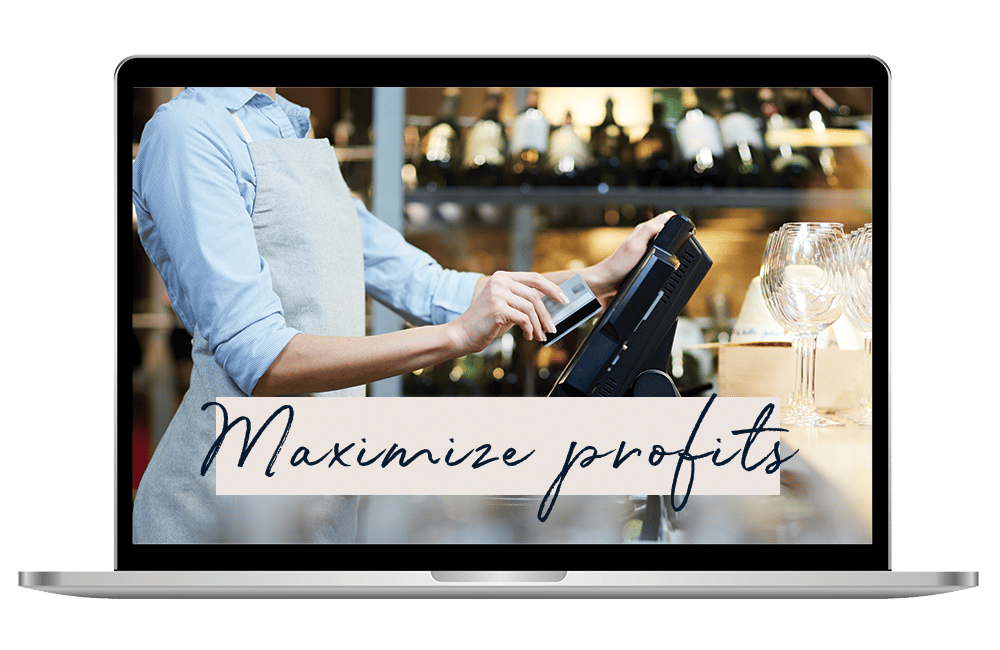
The three costly mistakes you could unknowingly be making?
Find out in this FREE guide and restaurant assessment specifically designed to reveal the unexpected hurdles standing between you and exponential business growth.
Thank You To Our Sponsors

Simplify and automate your accounts payable. Process, approve, and pay all of your company’s spend from anywhere – Request a Demo

The World’s 1st Incentive Management Platform for Restaurant Servers. Sparkplug Will Pay $200 For Your Restaurant’s 1st Incentive Campaign
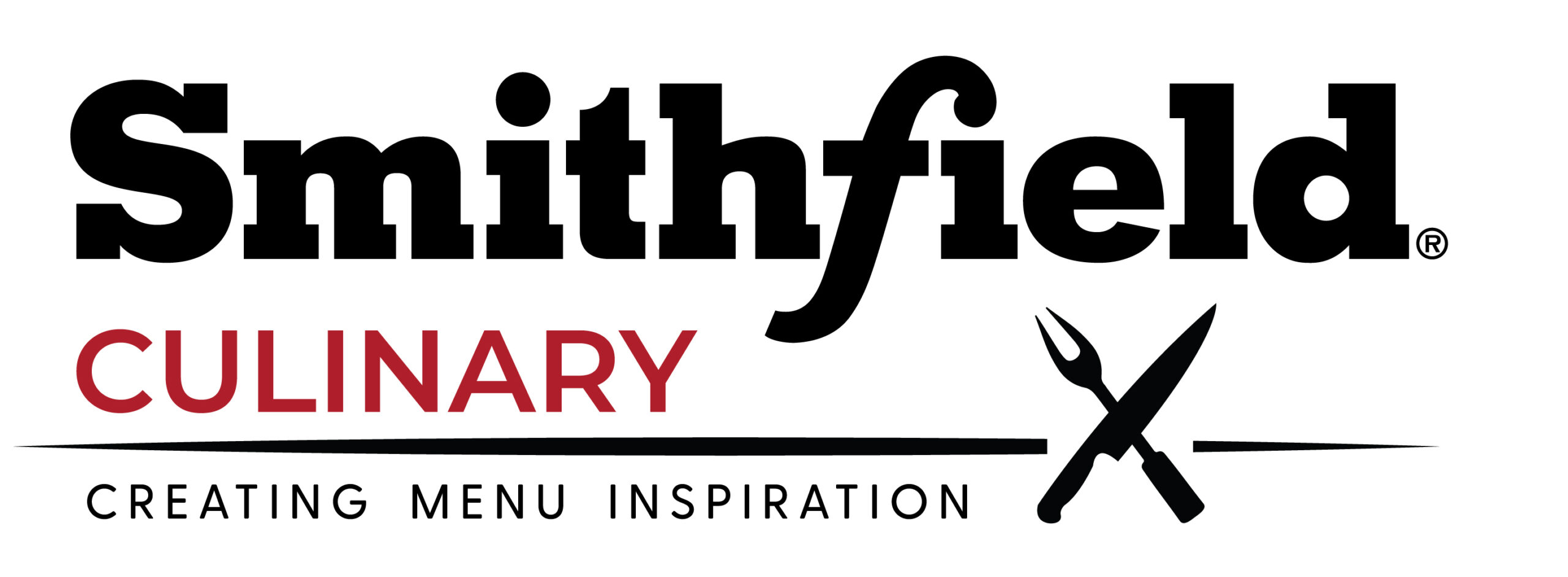
Inspiring Head-Turning Menu Creativity
Culinary Trends & Chef Inspired Recipes – Learn More
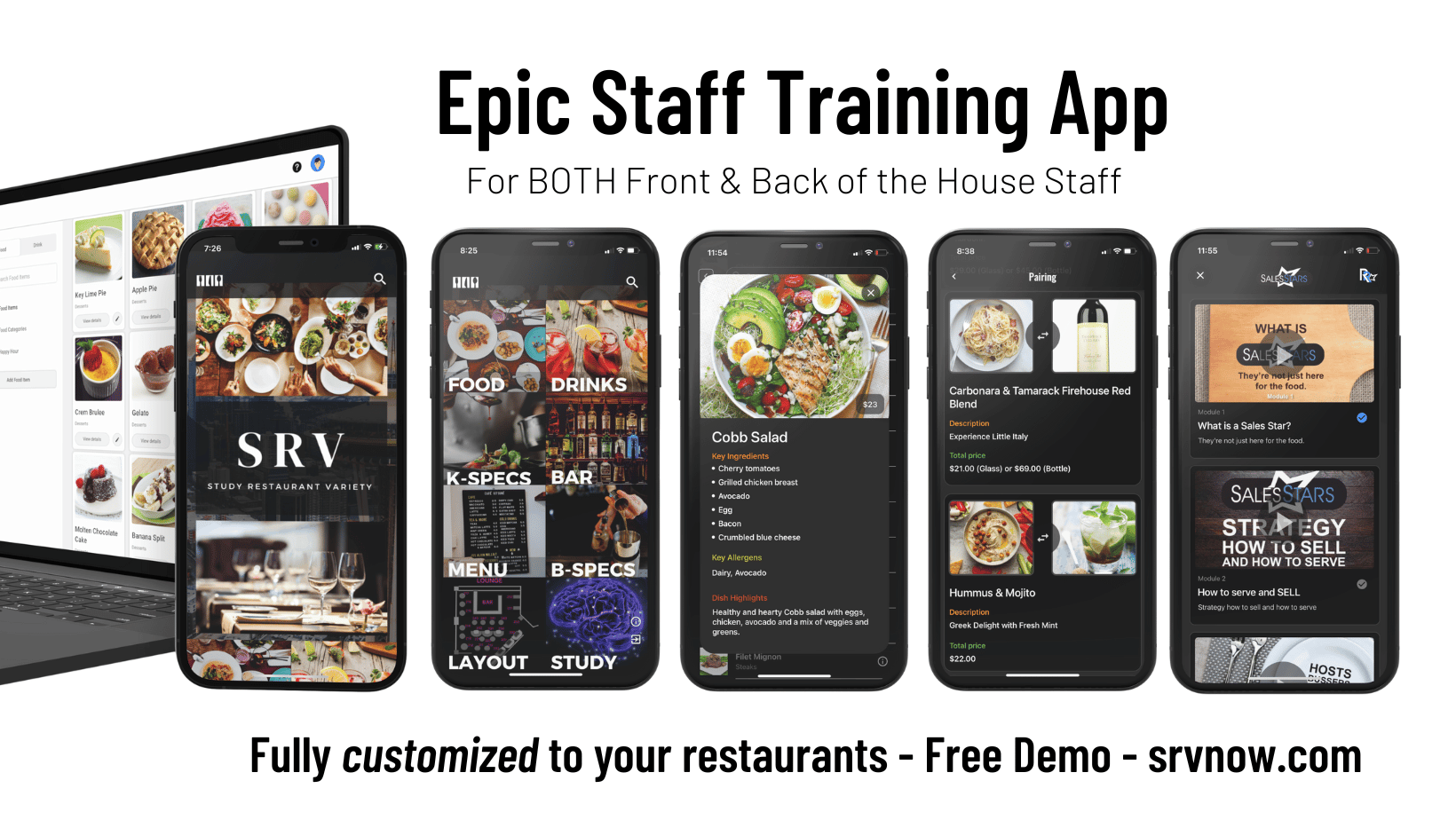
SRV teaches your team to profitably sell and accurately create the food and drinks at your restaurant.
Unlock Staff Potential and Maximize Sales
Want to become a podcast sponsor?
Please get in touch with Roger at roger@restaurantrockstars.com
